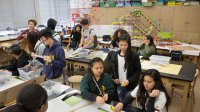How to Manage an Engaging Virtual STEM Program
A STEM initiative kick-started by the pandemic continues to have value in a district where some students are continuing with hybrid learning.
Your content has been saved!
Go to My Saved Content.As the coronavirus pandemic prompted school closures across the nation in early 2020, school districts scrambled to meet the needs of schools, families, and students, creating emergency remote education (ERE) to provide students with virtual instruction. However, ERE raised a number of concerns, including absenteeism and lack of student engagement.
In the Compton Unified School District (CUSD), an urban K–12 school district with approximately 24,000 students (85 percent Latino and 15 percent African American), more than 80 percent of students opted for virtual instruction during the 2020–21 school year. To minimize the impact of Covid—while maintaining focus on continuing our district’s science, technology, engineering, and mathematics program—CUSD integrated a series of virtual STEM-related activities within the ERE program.
The CUSD Education Technology Department created a variety of programs targeting specific goals within grades 3 through 12, and we recommend that the grades prekindergarten to 2 adopt the CS Unplugged program, which facilitates students’ understanding of the fundamentals of computer science without the use of computers.
Throughout the 2020 summer and fall school semesters, the EdTech Department sponsored seven districtwide engagement challenges immersing students within various facets of computer science.
1. STEAM camps: Three-day camps for grades 3 through 8 that introduced students to the engineering design process, app design, and video editing, as well as Scratch and Minecraft.
2. App prototyping: A six-week project for middle and high school students to learn how to build a hyperlinked slidedeck simulating a computer application that addresses a social justice or sustainability issue.
3. Scratch competition: An interdisciplinary four-week competition for students in grades 4 through 8 that taught them how to code with Scratch. Challenges included coding narratives or games that addressed the theme of the coexistence of humans with nature and celebrating Black History Month.
4. Minecraft competition: An interdisciplinary four-week competition for grades 3 through 8 in which students addressed the theme of sustainability using Minecraft.
5. Esports: Seven-week programs for middle and high school students playing video games with an emphasis on social and emotional learning and collaboration, as well as connecting them to career-related and technical education pathways.
6. Virtual career fair: A STEM-related career fair for middle and high school students to meet industry professionals synchronously or asynchronously.
7. Partner engagement day: Industry partners facilitated 90-minute hands-on STEM-related activities with middle school students.
4 Factors Guiding Our Online STEM Initiative
Collaboration: It’s essential to have a knowledgeable team in place to design and support STEM challenges. CUSD’s EdTech Department consists of a director and six specialists, each of whom took a leading role for one of the computer science activities, with the remainder of the team functioning in supportive roles.
The CUSD computer science challenges were designed based on the EdTech team’s interests and competencies, and a shared belief that the activities also address relevant social issues such as climate change and social justice. The team lead and team members supported one another in logistics, curriculum possibilities, instructional support, and creating learning assessments.
Other district department members became part of the team by taking on roles such as Zoom room hosts, competition judges, and physical assemblers of engineering kits for students’ remote learning. Even the superintendent temporarily joined the team. Our collaboration was the impetus behind students coding Scratch digital stories around Black History, building sustainable Minecraft living spaces, and prototyping apps.
Alignment: Even with modifications and accommodations owing to the pandemic, our team knew that it was important to make sure that curricular choices and activities align with various governing bodies. Each student-facing project aligns with NGSS, ISTE, and math standards. The EdTech Department operates its STEM initiative in alignment with the goals highlighted in CUSD’s Local Control Accountability Plan (LCAP) and in compliance with the state’s Local Control Funding Formula (LCFF).
Partnerships: CUSD leveraged partnerships with community and industry partners to support STEM initiatives. For example, partners served as computer science tutors who helped students build code, as well as judged competitions.
During the virtual career fair, industry partners provided the platform to host the event. For the partner engagement day, each CS partner was asked to design a 90-minute hands-on lesson for students (for example, Hack-a-Box), while the EdTech team organized classes of students into 90-minute rotating blocks in which community and industry partners taught lessons.
Addressing disparities in education and careers: Students have to be introduced to STEM in school if we expect them to pursue STEM-related careers. However, there is research marking the implementation and expansion of opportunities for computer science education as an issue of educational equity for students traditionally underrepresented in computer science.
Although students learning computer science is a chief technology education goal and part of a nationwide initiative (as STEM occupations are expected to grow), we currently face a shortage of STEM majors and graduates. Recognizing the dearth of underserved populations that enter STEM fields, CUSD designs various programs year-round to address this issue.
CUSD’s EdTech Department continues in ERE for the 2021–22 school year, now operating within a hybrid model. Feel free to connect with CUSD’s EdTech team for more information about our STEM initiative or how to pivot your STEM program to support students virtually.
